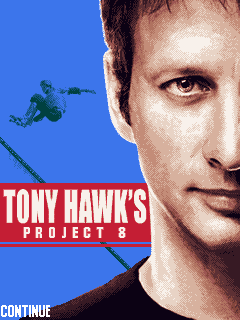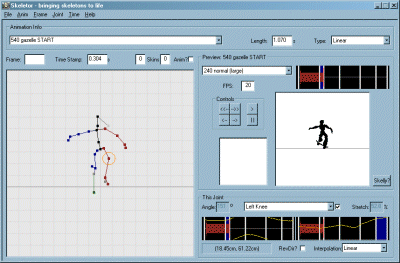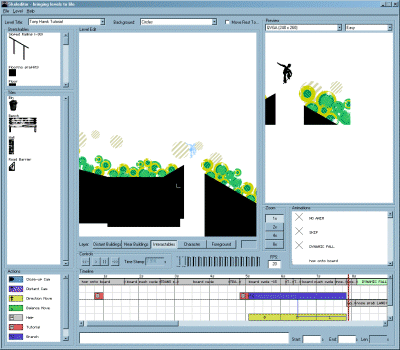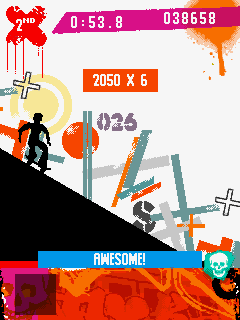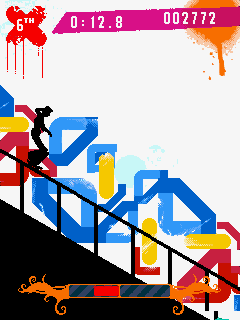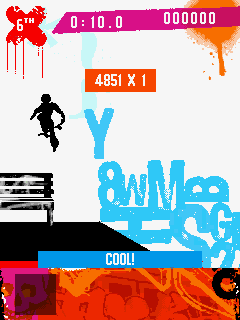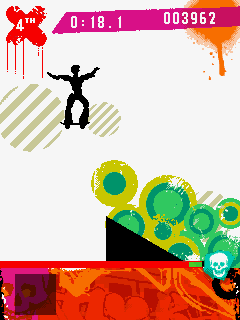| Home |
| 2008-2014 |
| 2007 |
| 2006 |
| 2005 |
| 2004 |
| 2003 |
| 2002 |
| 2001 |
| 2000 |
| 1998-1999 |
 |  | ||||||||||
 |  |  | |||||||||
 | Now, technically, I worked on another game prior to this one, but it didn't really see the light of day so I won't be giving it its own entry. I'll give a little bit of history on it, nonetheless. We were in discussion with a certain TV channel regarding a Parkour program they were promoting at the time. They were looking to get a mobile game tie-in and so we had a bit of think over what we could create. One of the initial ideas we came up with was implementing a kind of sprite-based skeletal animation system, combined with some basic rag-doll physics. We threw together a quick skeletal anim utility for a demo which went down well, but then a bit of a scheduling conflict came up.
We got wind that Infospace had negotiated a Tony Hawk license. That's not something you turn down. So, with a bit rejuggling of assignments, I was put onto that instead. At that time, Project 8 was coming out on consoles and... there was no way most mobile phones were going to be capable on anything even close to that. As we had the skeletal engine being played around with at that time, it seemed to make sense to optimise our processes and use the one utility on two products. Some slight tweakings, and we've now got a skeletal skateboarder.
A looooooooot of effort was put into the animations by the artists on those products. Going skeletal does mean you can do cute things like interpolations and in-game time dilations (slowing down and speeding up anims), which you can't do when you're hand-crafting individual frames of animation. Also, skeletal animation can be made to crunch down into quite small sizes (another benefit when we're still needing to consider that bottom end with the 64KB download limits). As for gameplay, we essentially ignored the direction the console game was going and decided to go with a graffiti / silhouette art style, and a Quick Time Event style of gameplay. Basically, the game would consist of a number of levels and you're board down and across a left-to-right scrolling landscape, pressing keys to perform tricks or balance at set points. To much failure and you'd crash and burn. Succeed and it's a basic high-score achievement kinda game. So, we needed some levels put together. Again, here we didn't want to go entirely sprite-based. To match up with the fluidity of the animations, we needed some way to chain animations together against the backdrop and implement animation branches depending on how well the player was doing. Enter custom utility #2:
I, err, I think I spent too much time on utilities. Anyway, the designer ended up laying out the floor and various boardable / jumpable items, with the graffiti background programatically infered from that placement. Artisically, I think we had an interesting style going on there. In the end though, it felt to me like half a game. A ton of effort went into, but it felt unpolished in places and compared to the gameplay length we'd had on previous titles, it felt really short.
It also suffered from another problem, and it's a classic one of QTE-based games. Directional and balance indicators would appear at the bottom of the screen and you'd need to rhythm-match your keypresses to meet when icons slid into an indicator box. The end result was you spent all your time focused on the bottom 20% of the screen. You're so focused on matching the keypresses that you completely end up missing all the action. It makes all the effort spent on the animations and artist effort go unnoticed. So, yeah, I don't know - it was alright, I guess, but I don't know if I'd play that style of game myself. |  | |||||||||
 |  |  | |||||||||

